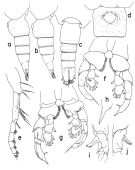|
|
 |
Fiche d'espèce de Copépode |
|
|
Calanoida ( Ordre ) |
|
|
|
Arietelloidea ( Superfamille ) |
|
|
|
Heterorhabdidae ( Famille ) |
|
|
|
Hemirhabdus ( Genre ) |
|
|
| |
Hemirhabdus amplus Park, 2000 (F,M) | |
| | | | | | | Ref.: | | | Park, 2000 (p.55, figs.F,M, Rem.) |  issued from : T. Park in Bull. Scripps Inst. Oceanogr. Univ. California, San Diego, 2000, 31. [p.185, Fig.33]. Female (from 31°12'N, 119°17'W): a, urosome (left side); b, urosome with genital somite somewhat inflated by deep telescoping of the following somite (left); c, urosome (dorsal); d, genital somite (ventral); e, right Mxp (anterior). Nota: Coxa of Mxp with 1+2 setae (Fig.33-e). Genital somite in dorsal view with nearly straight lateral margins (Fig.33-c) and in ventral view with the genital operculum close to anterior end of somite (Fig.33-d. Male: f, g, P5 (anterior, posterior, respectively); h, distal end of exopod of left P5 (anterior); i, j, second exopodal segment of right P5 (posterior, anterior, respectively). Nota: 2nd exopodal segment of right P5 with elongate mefial projection (Fig.33-i).
| | | | | NZ: | 4 | | |
|
Carte de distribution de Hemirhabdus amplus par zones géographiques
|
| | | | | | | Loc: | | | off San Diego, E Pacif. (tropical N-S), off W Austral Islands, Corail Sea, SW Indian, Madagascar.
Type locality : 31°12' N, 119°17 'W. | | | | N: | 1 | | | | Lg.: | | | (824) F: 11,83-10,5; M: 11,16-10,66; {F: 10,50-11,83; M: 10,66-11,16} | | | | Rem.: | Park (2000, p.56) notes when the two species H. grimaldii and H. amplus co-occurred in samples, this latter was always the larger (mainly the females).
This species differs from that of H. grimaldii by the genital somite having rather straight lateral margin, a depth about equal to the length, and a genital operculum close to its anterior end. The Mxp with the coxa, normally has o,ly 2 distal setae and 3 large pores on the anterior surface and the endopod normally has only 1 pore anteriorly. The male can be distinguished from that of H. grimaldii by the terminal spine of the left exopod, which is relatively short and tapers to a sharp spine, and by the fingerlike medial projection of the 2nd segment of the right exopod. | | | Dernière mise à jour : 12/10/2017 | |
|
|
 Toute utilisation de ce site pour une publication sera mentionnée avec la référence suivante : Toute utilisation de ce site pour une publication sera mentionnée avec la référence suivante :
Razouls C., Desreumaux N., Kouwenberg J. et de Bovée F., 2005-2025. - Biodiversité des Copépodes planctoniques marins (morphologie, répartition géographique et données biologiques). Sorbonne Université, CNRS. Disponible sur http://copepodes.obs-banyuls.fr [Accédé le 16 août 2025] © copyright 2005-2025 Sorbonne Université, CNRS
|
|
 |
 |




